PODCAST Manhattan’s Chinatown is unique among New York neighborhoods as its origins and its provocative history can still be traced in many of the buildings and streets still in existence. Two hundred years ago, the sight of a Chinese person would have astonished New Yorkers, and the first to arrive in the city were either sailors or the subjects of tacky exhibition.
But with the first Chinese men setting on Mott Street, a new community was born, with thriving variety shops, cigar businesses and gambling dens alongside establishments of a more sensuous nature — opium dens and brothels. This mini-economy produced social clubs and secret societies (the legendary ‘tongs’), and rival gangs soon spilled blood along the neighborhood’s quirkiest lane.
And still today, modern Chinatown hides a few dark, startling secrets of its own.
ALSO: We give you a rundown of addresses along Mott Street and other places nearby. You can use this podcast as your official walking tour of the neighborhood!
For a lot more information on the Chinese experience in America, I urge you to visit The Museum of the Chinese In America, located at 215 Centre Street. It’s free on Thursday and close to Chinatown. (Photo courtesy CUNY)
And here’s the addresses of places we mentioned in the podcast, as well as a couple other locations of interest. There are other places on these streets of great interest, so please meander freely:
1. 50 Spring Street – Quimbo Appo’s tea shop
Quimbo, an early Chinese success story in New York was in and out of prisons and mental wards later in his life. His son George Appo (below) was an equally notorious presence in the Five Points slums.
2. 62 Cherry Street – Ah Sue’s tobacco and Chinese Candy shop
The East River docks stretching to Corlears Hook, where the first Chinese men (sailors) stayed in boardinghouses. This image is from 1876; Ah Sue’s waterfront business was at 62 Cherry Street, near Catherine Slip.
3. Corner of Catherine Street and East Broadway
New York’s first Chinese laundromat
4. Chatham Square
In the 1880s, the open area was consumed with elevated railroad tracks, quite a
5. Confucius Plaza
Built in 1975 and one of the largest buildings in downtown Manhattan outside of the Financial District. (Picture courtesy the pretty fabulous blog Iconic Facades)
Not mentioned in the podcast, Port Arthur Chinese Restuarant, at 7-9 Mott Street, circa the 1900s, one of the first banquet halls of Chinatown
6. 11 Mott Street – the brothel owned by Tom Lee
7. 16 Mott Street – original home of the Chinese Consolidated Benevolent Association
8. 18 Mott Street – the first Chinese-owned building, and one of the earliest Chinese gambling dens
9. 25 Mott Street — Church of the Transfiguration
Easily the oldest structure in the neighborhood, and home to early congregations that weren’t exactly welcoming to Mott Street’s early Chinese residents.
10. 62 Mott Street — current home of the Chinese Consolidated Benevolent Association, the unofficial ‘town hall’ of Chinatown
Mott Street in 1942: (Courtesy the Charles W. Cushman Photography Archive)
11. Columbus ParkMany of Five Points most decrepit tenements were eliminated to make way for this park created by Calvert Vaux. The park is a lively part of Chinatown today, particularly on the weekends. [source]
12. 5-7 Doyers Street – Chinese Theater
A regular source of entertainment for locals and the sight of more than few altercations between rival tongs. Bodies were allegedly buried in the basement.
2 Doyers Street — Chinese Tuxedo Restaurant
Chinese had a powerful allure to the non-Chinese and to ‘bohemians’. This restaurant attracted businessmen looking for an ‘exotic’ night on the town. It helped that the Tuxedo was near the elevated train. (Courtesy Flickr/straatis)
13. 9 East Broadway – Former home of the Golden Star Bar
14. 47 East Broadway – Yung Sun Restaurant, once operated by Sister Ping

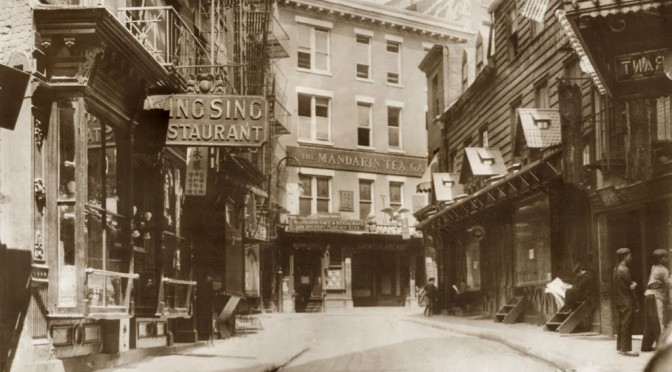
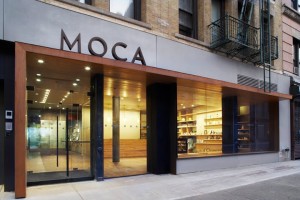
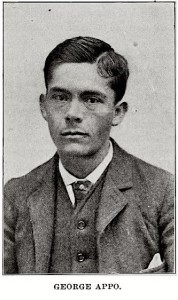
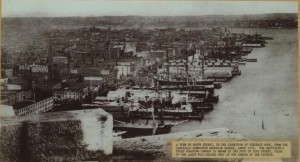
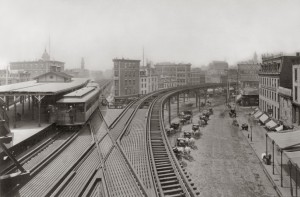
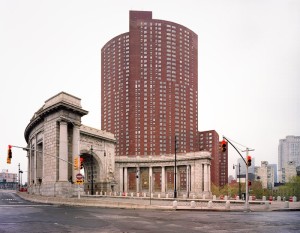
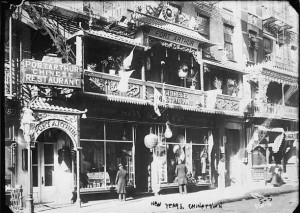
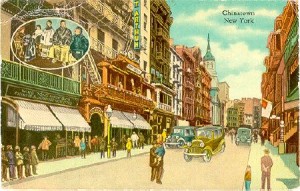
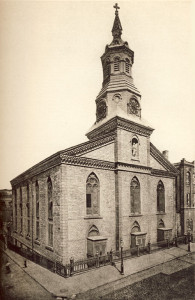
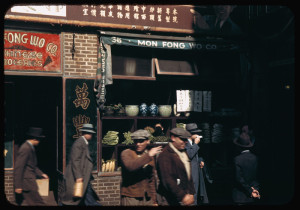
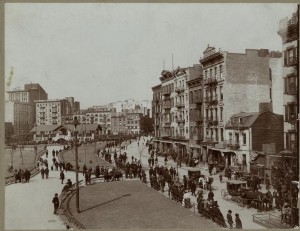
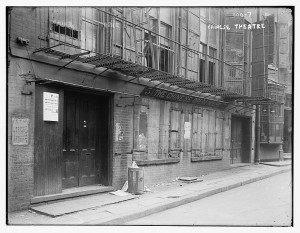
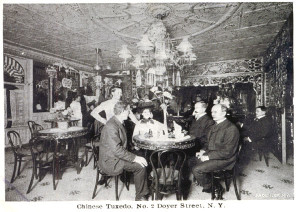
9 replies on “Manhattan’s Chinatown: a tribute to the old neighborhood, and to the temptations of rich delicacies and basement vices”
This is fantastic information in a concise and colorful format. The photos are wonderful. I work as a tour guide doing inexpensive Chinatown food tours. (How could it be expensive when the best foods are $1 and under!) The history of the area is largely unknown by tourists and native NYers like myself. My food tour goes beyond the “rich delicacies” you speak of– the stories of vice, gangsters, assassins, fascinating Doyers Street– one shouldn’t be allowed to eat in Chinatown without being forced to learn a little bit of the history. Food IS history. Thank you so much for the podcast, the photos, for it all! I’m looking forward to sharing the info with others!
I noticed a partial building sign “Mandarin Tea Ga…” in one of the photos illustrating the post. Do you discuss tea culture?
This comment has been removed by the author.
Excellent presentation… but a minor error is your confusion of hand laundries, which involved exhausting labor, with “laundromats and launderettes.” You are not alone as this is a common misunderstanding, probably with the virtual disappearance of Chinese laundries today. Self-service laundry services such as laundromats did not appear until around the end of WW II when small coin operated individual size washing machines allowed customers to wash, and dry, their own clothes. Unlike laundries, laundromats also did not iron or press clothes.
This is one of the most exciting blogs/sites relating to NY history I’ve come across. Amazing. Thank you.
i love this… i grew up in Knickerbocker Village, and was in Chinatown every day of my life, picking up vegetables, having lunch, dinner, shopping… everything. i miss the old neighborhood…
ok, i just realized you guys said Chatham Square with a pronounced “th” pronunciation. With 6 generations of my family living in the neighborhood since the late 1890’s, no one – absolutely no one – pronounces Chatham Square with a “th” sound. It’s pronounced “Chattam”… just so you know 🙂
Excellent information about the history of Chinatown! I never knew (Dawyer) street was considered as a bloody street, it was exotic to see an Asian woman in the 19th century, cigar rolling was a good occupation, birth of Chinese Restaurants, 1st gambling place was purchased in 1873 by Tom Lee, creation of the first brothel in Chinatown in 1901, the conflict between the 2 gangs, and death of the 4 Tong members, and how 1914 was the creation of the first apartment buildings ever created! There’s so much more that I’ve learned from listening to the information given from the Bowery Boys. Great use of the laws that Congress passed, the location of events in Mott St, Pell St, East Broadway and more, Bus lines, witness of events, Tom Lee’s documentation, Museum of Chinese of America and more. What if you were given a role to be apart of in the 1900’s of Chinatown, what role would you be apart of? Cigar Roller? Laundry shop owner? Restaurant owner? Anything, what would it be?
You make mention that the hand laundromat was at the corner of East Broadway and Catherine St. where would I find more information on this as I am an educator who works in the neighborhood but, need to confirm this.